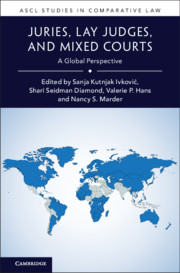Book contents
- ASCL Studies In Comparative Law
- Juries, Lay Judges, and Mixed Courts
- Copyright page
- Contents
- Editors
- Contributors
- Acknowledgments
- 1 Introduction
- Part I Advances in Lay Participation
- Part II Enduring Systems of Lay Participation
- Part III Challenges to Lay Participation in Law
- Part IV Global Perspectives on Lay Participation
- 14 What Hollywood, USA, Teaches the World (Incorrectly and Correctly) about Juries
- 15 The Case for a Hybrid Jury in Europe
- 16 A Worldwide Perspective on Lay Participation
- Name Index
- Subject Index
- References
14 - What Hollywood, USA, Teaches the World (Incorrectly and Correctly) about Juries
from Part IV - Global Perspectives on Lay Participation
Published online by Cambridge University Press: 03 August 2021
- ASCL Studies In Comparative Law
- Juries, Lay Judges, and Mixed Courts
- Copyright page
- Contents
- Editors
- Contributors
- Acknowledgments
- 1 Introduction
- Part I Advances in Lay Participation
- Part II Enduring Systems of Lay Participation
- Part III Challenges to Lay Participation in Law
- Part IV Global Perspectives on Lay Participation
- 14 What Hollywood, USA, Teaches the World (Incorrectly and Correctly) about Juries
- 15 The Case for a Hybrid Jury in Europe
- 16 A Worldwide Perspective on Lay Participation
- Name Index
- Subject Index
- References
Summary
This chapter examines American jury films and what they teach the world about American juries. Some of the lessons they offer are instructive, but others do not comport with American juries in practice. One persistent and misleading message of jury films is that juries include a holdout juror, even though holdout jurors occur infrequently on actual juries. The most famous American jury film, 12 Angry Men, teaches this lesson; however, it also shows a jury that ultimately works hard to arrive at a responsible verdict, which is what most actual juries try to do. This film is enjoying an extraordinary renaissance; it is being remade into foreign versions across the globe. This chapter also explores how 12 Angry Men serves as a window into American juries; foreign remakes of it also provide a window into the aspirations of countries around the world.
- Type
- Chapter
- Information
- Juries, Lay Judges, and Mixed CourtsA Global Perspective, pp. 285 - 303Publisher: Cambridge University PressPrint publication year: 2021



